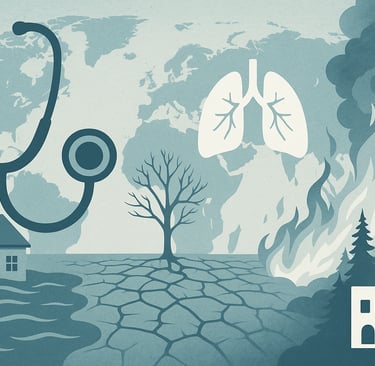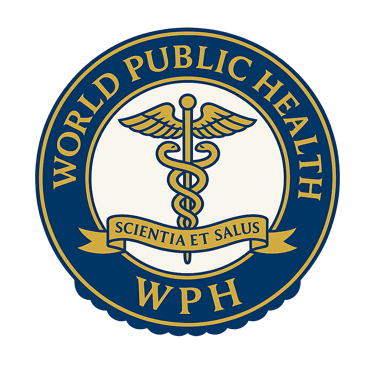Climate Change and Public Health: The Silent Emergency
By David Adeyemo, World Public Health
5/8/20243 min read


Introduction
The climate crisis has become one of the most significant public health challenges of the twenty-first century. Beyond melting ice caps and rising sea levels, it is a silent emergency that affects air, food, water, and human survival. The health consequences of climate change are no longer distant predictions; they are realities already shaping the lives of millions worldwide. From heat-related deaths to vector-borne diseases and food insecurity, every region faces its own dimension of vulnerability.
The Health Effects of a Changing Climate
Rising global temperatures have intensified heatwaves, droughts, floods, and hurricanes. These environmental changes directly and indirectly influence human health. Prolonged heat exposure increases cardiovascular and respiratory illnesses, while poor air quality exacerbates asthma and chronic lung conditions. Floods and heavy rainfall contaminate water supplies, leading to outbreaks of cholera and other diarrheal diseases.
Vector-borne diseases such as malaria, dengue, and Zika are spreading to new regions as mosquitoes expand their habitats. Similarly, agricultural disruptions threaten food security, contributing to malnutrition and stunted growth among children in low-income communities. The WHO estimates that climate change could cause approximately 250,000 additional deaths per year between 2030 and 2050 due to heat stress, malnutrition, malaria, and diarrhea.
Environmental Degradation and Disease
Deforestation, industrialization, and unregulated urban expansion have weakened the natural systems that sustain human life. Polluted air kills millions annually, while contaminated water and soil degrade the health of entire communities. In many cities, rapid urbanization has created dense settlements without proper waste management or green spaces, increasing vulnerability to both infectious and non-communicable diseases.
The destruction of natural habitats also facilitates the emergence of zoonotic diseases — infections that jump from animals to humans — a trend clearly observed in outbreaks like Ebola and COVID-19. Protecting biodiversity is therefore not only an environmental goal but a vital public health strategy.
Vulnerable Populations and Global Inequities
The effects of climate change are not evenly distributed. Communities in low-income nations, coastal regions, and small island states suffer the greatest impact, despite contributing least to global emissions. Women, children, the elderly, and displaced populations are disproportionately affected. This inequality highlights the deep moral dimension of the crisis: environmental injustice is also health injustice.
Urban poor communities often live near polluted industrial zones or flood-prone areas, lacking both healthcare access and adaptation resources. For them, climate change is not an abstract issue but a daily struggle for clean air, safe water, and basic survival. The pursuit of climate justice must therefore be integrated into all public health frameworks.
Policy, Adaptation, and Mitigation
Global health institutions increasingly recognize that climate action is health action. The WHO’s “Health and Climate Change Global Survey” calls for national adaptation plans that integrate environmental data into health policy. Countries are encouraged to strengthen health infrastructure, improve disease surveillance, and promote renewable energy to reduce pollution.
NGOs like World Public Health can play a key role in bridging science, community engagement, and advocacy. Local education campaigns, early-warning systems, and sustainable agriculture programs can save lives long before emergencies occur. Cross-sector collaboration between health ministries, environmental agencies, and civil organizations will determine how effectively the world adapts to this evolving threat.
The Path Forward
The path to climate resilience requires a global commitment to sustainability and social equity.
Integration: Climate change must be recognized as a central determinant of health in national policies.
Innovation: Data-driven forecasting, green infrastructure, and digital health monitoring can guide prevention.
Inclusion: Vulnerable communities must participate in decision-making to ensure that policies reflect real needs.
A coordinated global effort can transform today’s crisis into an opportunity for sustainable progress. Protecting the planet’s health is inseparable from protecting humanity’s future.
Conclusion
Climate change is not a distant threat but a living emergency unfolding across borders and generations. The health of every person depends on the stability of the environment that sustains us. Governments, scientists, and citizens share a common responsibility to act. As organizations like WHO, UNDP, and World Public Health continue to advocate for climate-resilient health systems, the challenge remains clear: without a healthy planet, there can be no healthy people.


About the Author:
David Adeyemo, RN, MSN, MPA, MS-HRM, CPH, PhD(c), is the Founder and President of World Public Health. He is a public health nurse, Army medical officer, and global health scholar dedicated to advancing public health leadership and equity worldwide.
